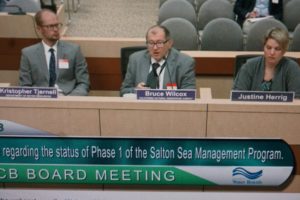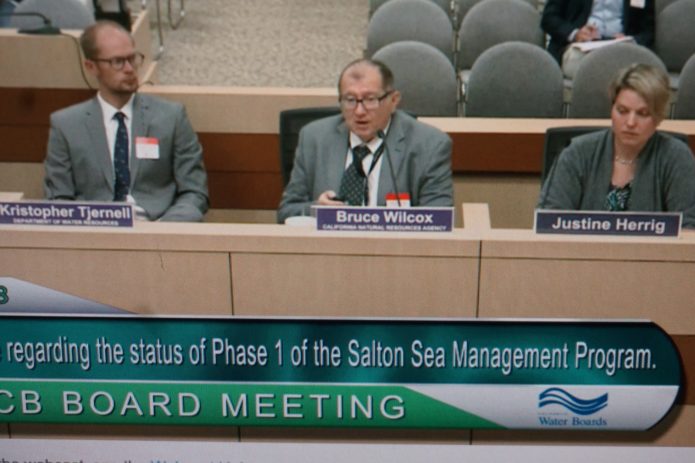
Bruce Wilcox (center) assistant secretary in charge of Salton Sea policy for Califonia Natural Resources, notifies the State Water Resources Control Board on delays in the Salton Sea Management Program but identifies plans to get caught up in the years ahead. To Wilcox’s left is Kristopher Tjernell, newly hired by the Department of Water Resources to help advance DWR’s work on the Salton Sea. To Wilcox’s right is State Water Board staff member Justine Herrig.
The State Water Resources Control Board heard an update on the Salton Sea Management Program (SSMP) on Tuesday, Oct. 16, with Board Chairwoman Felicia Marcus telling state officials working on the Sea that she needs to see more “drive” to get projects done. Her comments were a message of both optimism that construction will soon begin on projects and disappointment with the news they were presented with during the discussion—that the first milestone under the SSMP will not be met. However, in the end, the State Water Board gave a nod to the California Natural Resources Agency (CNRA) and the State Department of Water Resources (DWR), which are showing signs of positive momentum.
Tuesday’s discussion was one of an ongoing series of meetings the State Water Board (Board) will have on the Salton Sea as the Board now has authority over monitoring restoration efforts at the Sea under a water order the Board approved in November 2017. That water order, along with giving the Board jurisdiction going forward over restoration, established annual milestones over the ten-year Phase One of the SSMP. The water order, drafted by the Imperial Irrigation District, Imperial County, the San Diego County Water Authority, environmental agencies, and the State, establishes that over the next ten years, the State must cover some 30,000 acres of exposed playa with a 50-50 mix of habitat and air quality projects. Annual acreage milestones were also established. For 2018, the State was to cover 500 acres.
Bruce Wilcox, assistant secretary for CNRA in charge of Salton Sea policy, told the Board that first milestone will not be met. He said the SSMP can provide air quality projects that would include such steps as tilling the land and enhancing vegetation to prevent blowing dust, but the program will not be able to provide the habitat projects for the year. However, he declared that by 2022, any milestones missed will be addressed and the SSMP will be on track. Wilcox said one of the primary reasons for the delay in habitat projects was the need to finalize land use (easement) issues with IID, but he said the State and IID are working hard to resolve issues, and he anticipated projects will soon move forward. Additionally, he told the Board that recent studies determined that while the fish population has decreased at the Sea, there continues to be fish in all stages of life, which means the Sea has not yet lost its ability for reproduction of fish life. A key part of the SSMP is to provide both fish and bird habitat while also protecting human health.
One of the key concerns that has been raised on the SSMP is whether there is enough dedicated staff and leadership to manage the programs and move projects forward. On Tuesday, joining Wilcox at the podium was Kristopher Tjernell of DWR whose role is to help lead efforts at the Sea. Tjernell told the Board that DWR has gone through a reorganization with the goal of addressing the leadership needs for the Sea. He presented a new DWR staffing chart that listed a series of project manager positions and engineering positions that will be dedicated to the Sea. Board members voiced optimism that such positions will help expedite work at the Sea.
Members of the environmental community expressed both concern and optimism about the State’s efforts, stating they have attended SSMP update meetings like this one and heard about the projects that are coming, but still there has been no construction of such projects. However, they acknowledged DWR’s staffing changes could help and. urged the Board to hold another meeting on the Sea in January with the hope that at that time, the State could report that some projects will have begun construction.
Among the positive signs of development is the work moving forward at the Red Hill Marina project, which calls for building more than 500 acres of shallow habitat on the southern shore of the sea. Wilcox reported the earth work has been completed, pumps have been ordered to move water into the habitat area, and an arrangement is in development with IID to provide power for the pumps. He said the project is expected to be completed in 2019. Similarly, work is expected to move forward on phase one of the State’s Species Conservation Habitat project—a 640-acre project near the southern end of the sea. That project is permitted and funded. Additionally, with bond funding already approved by voters, and a new bond going before voters in November, the sea could have $465 million available by year’s end to implement the first ten years of the SSMP.
